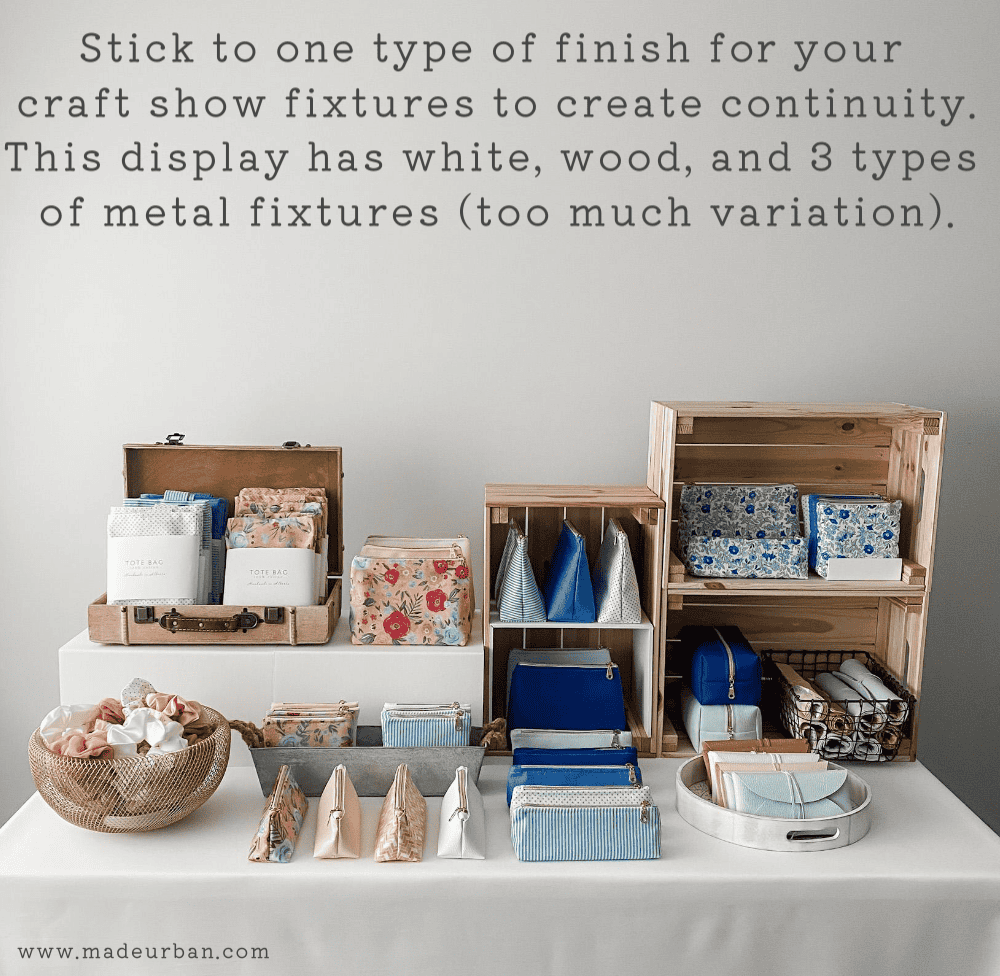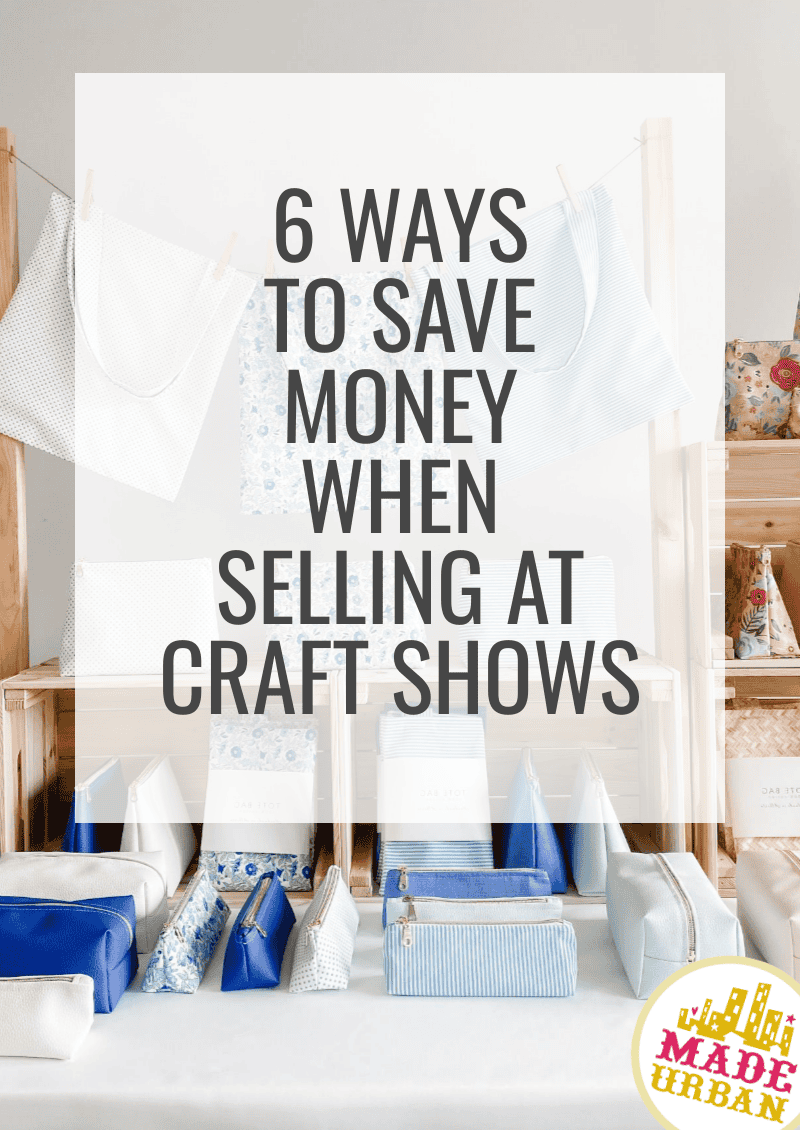6 Ways to Save Money when Selling at Craft Shows
It’s best to spend conservatively when preparing for your first craft show. You may love or hate selling at markets and events.
You also don’t know how shoppers will respond to your products. Some sell better at craft shows than others.
However, you still want to make a good first impression and optimize sales.
Here are a few ways to save money when preparing for your first craft show.
1) Choose a smaller event
It’s too late if you’ve already been accepted to your first craft show. But if you’re reading this before applying to a craft show, choose one that’s smaller.
- Smaller venue
- Lower table fees
- Fewer shoppers
The payoff won’t be as big, but the risk is lower.
Don’t choose a 3-day outdoor event that requires you to buy an expensive vendor tent.
Start with a smaller 1-day event.
That being said…don’t choose just any event. Make sure the shoppers the event will attract (though its branding, marketing, and types of vendors) are the type of shoppers your products are ideal for.
2) Limit stock
Trying to determine how much stock to make for a craft show, let alone your first craft show, is always a guessing game.
You can use my guide here, which will help you guess/calculate as accurately as possible.
However, there are too many unknown variables to be fully prepared in the inventory-level department.
First-time vendors tend to spend too much time and money on their stock.
They want to have something for everyone and offer several options. And of course, they worry about not having enough stock, so they burn the candle at both ends trying to make anything and everything…and lots of it, before their first show.
Cut back on how many types of products you make, which will save you time and money when it comes to:
- sourcing materials
- material costs (you can often buy in bulk to get a bigger discount, but when you’re buying a small amount of each material, it’s harder to find discounts)
- learning how to make new designs/patterns or use different techniques
- determining prices
- figuring out how to display each item
- creating signage for each item
- etc.
I know…creating the same item over and over isn’t as fun, but you become much more efficient when you do.
3) Repurpose items
Your craft show display should look cohesive, but you should be able to gather items from around your home to use in your display. Just try to stick to one color/finish.
Don’t grab a wooden tray, a gold metal bowl, and a white crate. Choose items that are wood, or gold metal, or white, but not all three.

Depending on what types of products you sell, you may be able to use items such as:
- Bowls
- Trays
- Storage baskets/crates
- Jewelry boxes
If you don’t have items that match, shop at a thrift store, dollar store, or Ikea to find items you can repurpose for your display.
Items from a thrift store can be painted or covered to match.
As you invest in more craft shows and turn a profit, you can spend some of the profits on fixtures that are a better fit for your brand.
4) Reduce or eliminate common expenses
There are several expenses associated with a craft show, outside of table fees and stock costs. You’ll find a list of common expenses here: 10 Costs of Selling at Craft Fairs
A few ways you may be able to reduce those expenses are:
- Keep it local – apply to craft shows that are closer to home. This will save you money on gas, time driving to and from the event, hotels, etc.
- Pack a lunch – many craft shows will have food trucks, which are hard to resist. However packing a lunch with save you money.
- Find free parking – in my experience, many craft shows are downtown or in busy areas with high parking fees. Scope out the parking situation ahead of time so you know where the cheapest parking lots are, and give yourself lots of time to find parking the morning of. Load products and fixtures in then drive a little further to find cheaper parking. Better yet, ask a friend or family member to drop you off (they can help you with loading in and setting up).
5) Let go of perfection
It’s your first craft show. You don’t have to have it all figured out.
You’ll learn more through a few hours of first-hand experience than you will reading every article on Made Urban 😉
Keep things simple.
>> You don’t need every product you’re capable of making
>> You don’t need to offer dozens of options
>> You don’t need a branded display
There are a lot of things you can do to prepare for a craft show.
But if you show up with your products and set them on a table, you’ll be fine.
Go into it with an open mind and be willing to learn.
6) Get your money’s worth
This one won’t help you save money, but it will help ensure you get more out of the craft show than you put into it.
Don’t look at the event just as a way to sell your items that day.
- Make connections
- Learn from other vendors
- Gather feedback from shoppers
- Observe shoppers at other booths (what do they buy, which booths seem to be making the most sales? Busiest doesn’t mean the most sales)
- Market your business
- Etc.
Craft shows should be treated as a sales channel and a marketing channel. If you’re only focusing on the sales that day, you’ll miss opportunities to grow your business in other ways.
I hope this article helps you save time and money going into your first craft show!


Hey, I’m Erin 🙂 I write about small business and craft show techniques I’ve learned from being a small business owner for almost 2 decades, selling at dozens of craft shows, and earning a diploma in Visual Communication Design. I hope you find my advice helpful!

Good advice. I’m a few shows in, and several investments, and wondering where & how to level up for bigger and less local shows. I’m in a very rural area where towns of 1,200-5,000 are 50-100 miles apart. Any advise there?